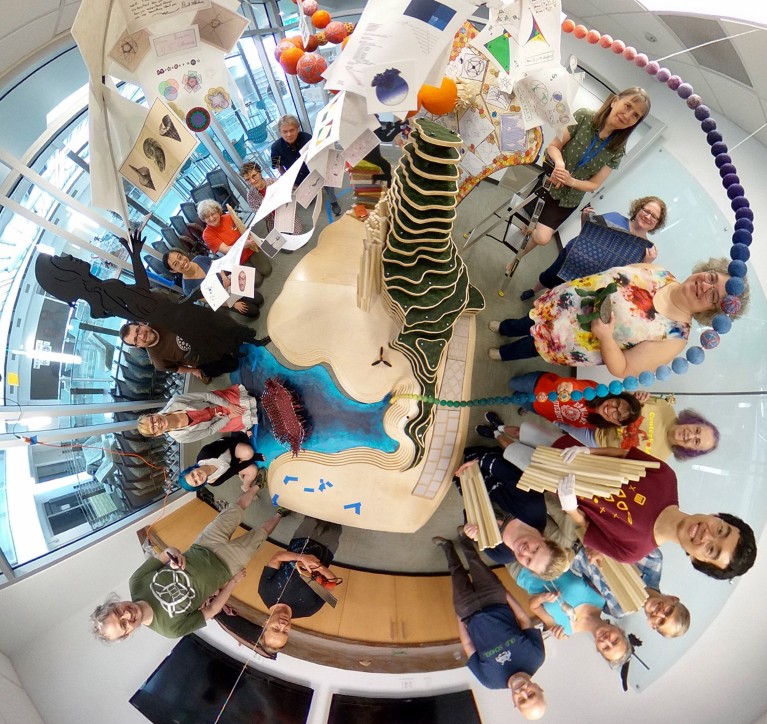
The Mathemalchemy team of 24 mathematician-artists dreamt up this installation’s storyline.Credit: Henry Segerman
When researchers collaborate across disciplines, their partnerships can spark insights that wouldn’t be possible without the interrogation of ideas from many perspectives. Yet these collaborations can be challenging to forge and maintain.
“Perhaps one of the most nuanced types of collaborations is between mathematics and the natural sciences,” says Christopher Hendon, a chemist at the University of Oregon in Eugene. “There’s a reason you don’t see it very often — because that’s a really difficult collaboration to foster.”
Hendon partnered with Jamie Foster, an industrial and applied mathematician at the University of Portsmouth, UK, and coffee-industry specialists to investigate how to brew high-quality espresso reproducibly. “Mathematics is difficult, and I think sometimes mathematicians forget they’re uniquely skilled at it,” he notes.
Nature spoke to six researchers — three mathematicians and three from other fields who have partnered with them — about crafting successful and lasting collaborations.
INGRID DAUBECHIES AND DOMINIQUE EHRMANN: A multimedia celebration of mathematical beauty
Mathematician and physicist at Duke University in Durham, North Carolina; fibre artist, working with fabric, yarn and other textiles, based in Sainte-Sophie, Canada.
Ingrid: For many years, I have been fascinated by the beautiful objects that mathematicians who are also craftspeople, as well as artists who are interested in maths, make and exhibit at maths conferences. I thought it would be wonderful to see them creating a larger installation.
In August 2019, I saw Dominique’s installation Time to Break Free, inspired by the steampunk art movement, which told the fanciful story of a quilt that was absorbed by a steampunk machine and transmogrified into living characters. It was impressive.
I thought that maybe Dominique could help to organize a project with mathematicians who are also crafts-people. I contacted her and she was game.
In 2020, we presented our proposal at the Joint Mathematics Meetings — the largest conference of its kind in the world — in Denver, Colorado, at a special section on maths and the arts. We proposed a collaboration of 15 people — we ended up with 24.
We had people from the fields of dynamical systems, signal analysis, topology, algebra and mathematical biology. And we had people who were into sewing, crochet, knitting, woodwork, stained glass, embroidery and ceramics.
To design the installation, entitled Mathemalchemy, we started with this big peninsula-shaped platform in which different scenes of a story could play out. For each one, people made a pitch and then those who were interested in elaborating on the scene joined up into subgroups.
For an interdisciplinary project to work well, the ground rules must emphasize that everybody is listened to. When you ask questions that are to do with somebody else’s expertise, they shouldn’t simply say, “Just believe me.” Communication and trust make it possible for all to work together and create something that couldn’t have been created by any small subset of the group.
Scientists who have never worked with mathematicians don’t really know what mathematicians do. They often don’t see mathematics as a creative framework. They might have a complicated computation or model that they don’t understand, and be looking for help.
When that happens, I don’t say, “I’m not just a hired gun.” I say, “I want to learn more about this problem. Do you have time to explain?” It’s best to work with people who are willing to spend time with you to ensure that you can learn. Otherwise, it’s not going to be productive. You might still be a useful hired gun. But then it’s not the kind of interdisciplinary collaboration that I think is most valuable.
Dominique: I was a chocolate maker and cake baker for 25 years before becoming a fibre artist and quilting teacher. Without knowing it, I have always been influenced by geometric shapes.
When Ingrid saw my piece Time to Break Free, she saw the maths in it. She saw that I was also giving workshops and I had some experience with 3D art.
The 24 Mathemalchemy collaborators were able to meet in person and learn to trust each other before everybody was locked down owing to the COVID-19 pandemic. After we clicked, the impact of one idea was multiplied by five, six, ten times.
Each idea for creating and refining the scenes in the installation was rejected or approved by the group, and the collaboration made the concepts so effective and so much more powerful. Our brains — they don’t work in the same way for artists and mathematicians, in my experience, but they complete each other and benefit from each other.
I’m changed; I won’t be the same artist after the experience of Mathemalchemy. Now I have the gift of tools to understand maths in a different way. I see the poetry in maths. I see all the colour.
The mathematicians were all familiar with research, which is always in the process of being completed. But when you create a piece of art, you eventually need to stop. I was nervous that we wouldn’t have time to produce all the things that were approved. That was my biggest challenge: convincing them we needed to stop. It didn’t work 100%. They kept adding small ideas.
We all led, and we all followed. In a collaboration, you need to accept that your ideas won’t always be accepted. If you absolutely want something to happen, you need to be able to prove your point.
And you should be interested in a playful way. Even if something is very serious, you need to have fun, because when you come to the work from a state of happiness, you have more creativity and fewer walls.
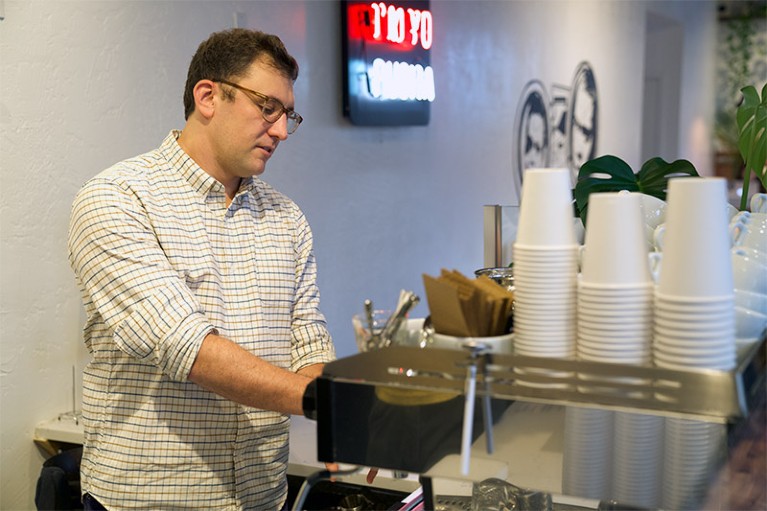
Chemist Christopher Hendon teamed up with applied mathematicians and coffee brewers to investigate the parameters for a perfect espresso.Credit: Dustin Whitaker
CHRISTOPHER HENDON AND JAMIE FOSTER: complementary teams make a worthwhile brew
Chemist at the University of Oregon in Eugene; industrial and applied mathematician at the University of Portsmouth, UK.
Christopher: The coffee industry realized that there was a problem with quantifying what comes out of an espresso puck — the compacted bed of ground coffee, shaped like an ice-hockey puck, that water percolates through. You can’t really know what’s happening inside; therefore, you don’t have the predictive ability to understand what will happen as water moves through the compacted coffee.
As a chemist, I’ve been thinking about molecules and water moving across the interface of water and coffee particulates. My group made some experimental observations, that if we ground the beans at certain coarseness settings, we saw large variance in how much coffee material was extracted. But we didn’t have a good way of modelling or understanding what was happening.
About five years ago, I was invited to give a seminar at the University of Portsmouth, UK. I presented some of our unpublished data and the challenges we had. That’s when I met Jamie, who is an applied mathematician. I brought coffee expertise, and he and a student did the hard work of developing the numerical model. It helped us to determine how to make consistently extracted shots of espresso every time.
The model showed that you could change variables such as grind setting or water pressure — and that, for example, if you grind more finely, which gives a higher surface area for the coffee particles, you can extract more espresso. You can also extract more if you pump at lower pressure, because the water is in contact with the coffee for longer. We found that the model mapped onto our experiments very nicely, to a point.
I’m not nearly as good at partial differential equations (PDEs) as Jamie is. These equations help to optimize each parameter for our model. For example, we don’t know the ideal coffee mass, water pressure and particle size, but we can use a system of PDEs to minimize the model’s dependence on each parameter.
I helped to act as a bridge between the mathematics and the coffee professionals we worked with. I sometimes think that my role was more about understanding enough from both sides to help everyone communicate with each other.
Jamie and I got along well and had a shared interest in coffee. You get to choose who you work with and, hopefully, the friends you find are also skilled and contribute to your research program. If their skill sets and interests overlap but are dissimilar to yours, that’s a good starting point.
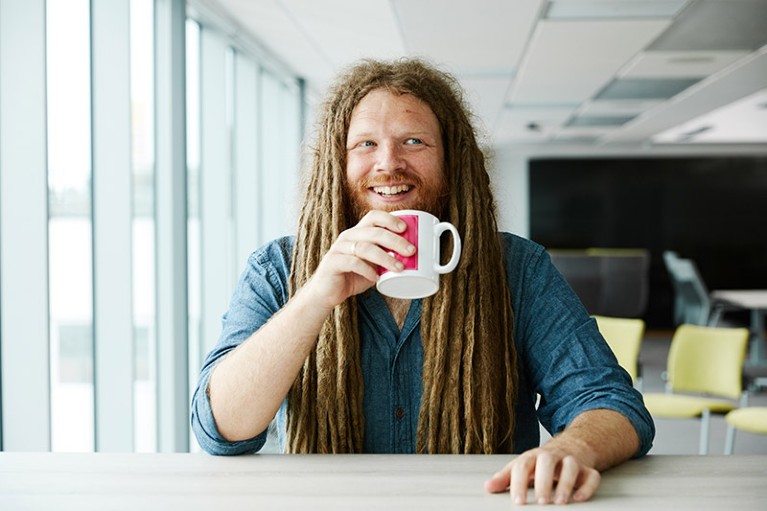
Jamie Foster helped to brew the perfect cup.Credit: University of Portsmouth
Jamie: When Chris gave his seminar at Portsmouth, it struck me that there were very few physical models for coffee chemistry in the literature.
The specific problem I worked on with Chris is the brewing of coffee. It was nice to find a topic that, basically, no other mathematician was really working on. It’s a difficult thing to get a grip on, because people don’t agree on what good coffee tastes like. Mathematicians and physicists — people like me — like well-defined problems. This was a moving target.
I dived into helping Chris to understand some of the problems that chemistry alone couldn’t tackle, by trying to bring some physics and mathematics to them.
We basically set aside flavour profile and looked instead at extraction yield, a metric that’s well characterized (M. I. Cameron et al. Matter 2, 631–648; 2020). When baristas make coffee, they can measure the yield. It tells them how efficient the brewing process was, how much wastage there was, and gives an idea of how strong the coffee is going to taste.
Producing the mathematical model for the yield required my skills in formulating, solving and analysing equations. But we couldn’t have got the experimental data to validate the model without Michael Cameron, a barista based in the Gold Coast, Australia. And the question of whether you can improve efficiency would probably never have arisen without Chris’s input.
Making sure people understand each other properly is always difficult when you collaborate across disciplines. There are words that both sides use but might mean very different things to each of them. Translation was the biggest challenge. To give an example, as a mathematician, when I say ‘a model’, I mean a mathematical problem that represents something in the real world. But if you ask a chemist such as Chris, they would probably use the term interchangeably with ‘working theory’ or ‘hypothesis’.
Mathematicians see the world mainly through the lens of equations, whereas chemists might see it through word-based explanations. This shaped the paper we eventually wrote, because we spent a lot of time taking the results of the mathematical model and thinking hard about how to translate these into verbal conclusions that could be parsed by non-mathematicians.
Sometimes, you get some way down the road in a discussion and realize that you have been talking at cross purposes for the past half an hour. Regularly check with your collaborators to ensure that the message sent is the message received. Ask, “Could you re-articulate to me what you think I just said?”, and then listen to make sure you get the right thing back.
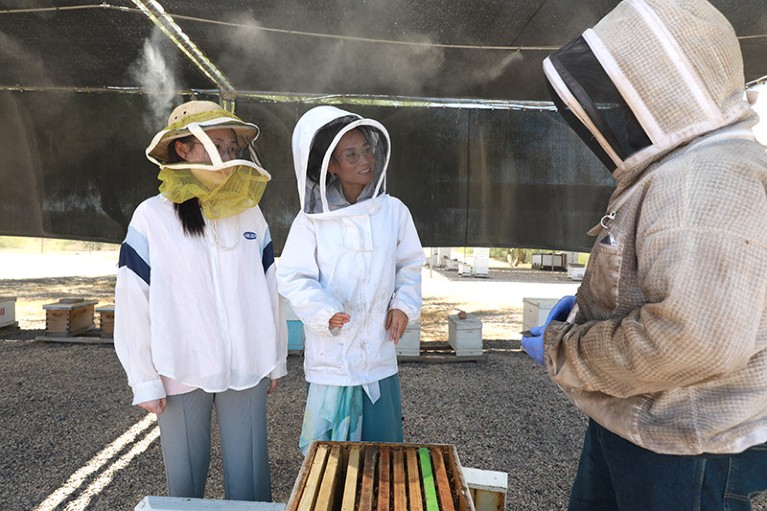
Mathematicians Jun Chen (left) and Yun Kang (centre) model honeybee populations.Credit: Junmin Zhong
YUN KANG AND GLORIA DEGRANDI-HOFFMAN: Ways to halt declining honeybee populations
Applied mathematician at Arizona State University in Mesa;, entomologist who leads research at the US Department of Agriculture’s Carl Hayden Bee Research Center in Tucson, Arizona.
Yun: The project that I have been working on with Gloria is related to honeybee parasites and diseases.
We can learn, on the basis of the colony’s social structure, how disease spreads and how the insects interact with the parasites. And we can apply what we learn to human society.
As mathematicians, we can read about things in biology, but, ultimately, we aren’t biologists. Instead, we have great training in applying mathematics to a biological problem. You cannot just come up with a model; the model must be validated by the data, so that it can be useful. By collaborating with biologists, we can make a model much more realistic and link it to experiments.
We can also guide the biologists by saying, “There are certain parameters that are more sensitive to dynamics. Maybe it would be good if you measure this other parameter’s values, too.” Then they might consider a more precise or better experimental protocol.
To succeed in establishing collaborations, you need to be proactive. Go to other researchers’ seminars and laboratory meetings so that you can understand what’s important and start speaking the language of their discipline. Talk to them, ask questions and read related articles.
Gloria: My specialism is entomology and, with honeybees specifically, I do population modelling.
Yun and I met in 2015 at the Conference on Complex Systems at Arizona State University in Tempe. I gave a presentation there and talked about our honeybee population-dynamics models, including what we use them for — such as investigating how well mite-control products work in different honeybee colonies — and how we develop them.
I really like working with mathematicians. I learn a lot from them. They have perspectives that are very different from mine, as a biologist. They’re great collaborators.
Looking at bee-population research from a mathematician’s point of view involves how things interact in the system. For example, how do honeybees interact with a parasite in their colony? How do those two populations grow together?
I supply the mathematicians with all the population dynamics and data that we collect in field experiments. Yun or another mathematician will describe the results using equations, and then use data to construct models that capture the dynamics of what’s measured, over time. At that point, we can begin to light up the model and it will generate predictions and trends. Then we look at the numbers together and ask, “Does this seem reasonable? Have we captured reality here?”
For example, Yun’s PhD student Jun Chen built a model, using our field data, that described the seasonal impact of parasitic varroa mites on honeybee colony growth. The model generates interactions involving factors such as queen egg-laying rates and the resulting parasite population growth, and it defines points at which the colony can survive or the population becomes unstable. We know that colonies can collapse owing to varroa infestations, and the model describes conditions that can lead to what seems to be a strong colony in the summer collapsing in the autumn or early spring.
Society is counting on science to find solutions to challenges, such as climate change. Looking at problems from an interdisciplinary perspective and getting together groups of people with different expertise is essential to solving them.
It’s good to talk to potential collaborators in your department or agency, and at scientific meetings. Read broadly. Looking at interesting things outside your area helps you to bring fresh ideas into your work. Mathematicians have a lot to offer.
The possibilities are so good to do this kind of work now. When I first started, we were trying to program models on mainframe computers. They weren’t portable like today’s laptops. And it was harder to have proper discussions with your collaborators; you couldn’t meet on Zoom like we do now.
There’s so much out there that can be pursued so easily — it’s just a question of having the desire.





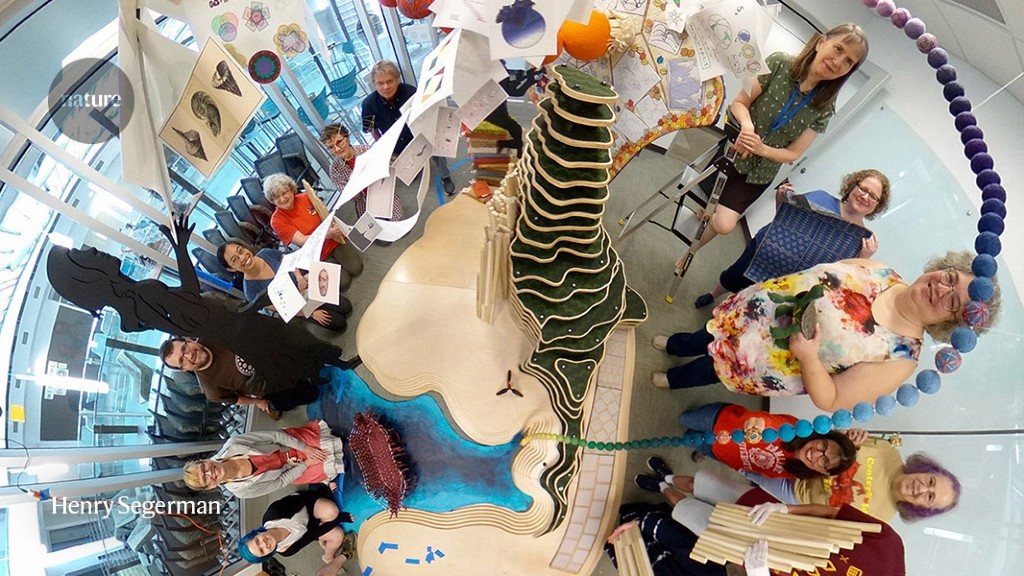
More News
Author Correction: Stepwise activation of a metabotropic glutamate receptor – Nature
Changing rainforest to plantations shifts tropical food webs
Streamlined skull helps foxes take a nosedive